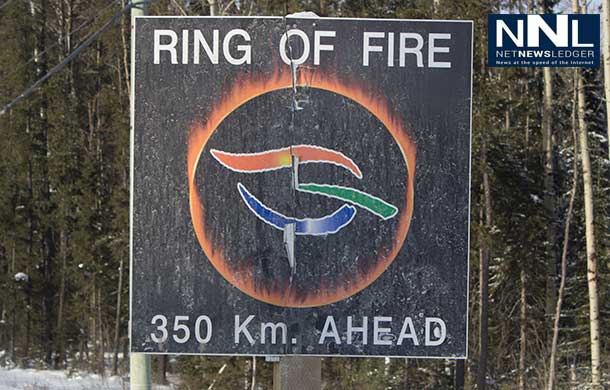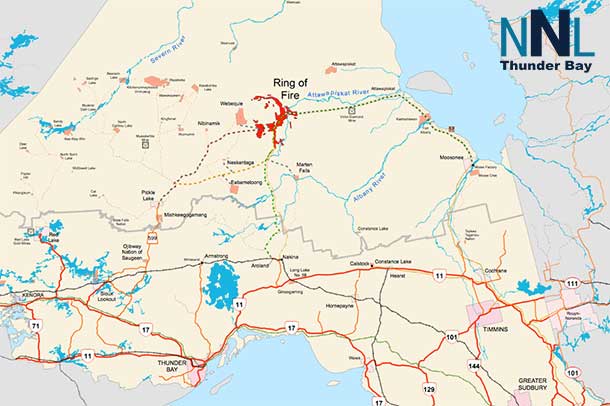Ring of Fire – Getting it Right Rather than Getting it Soon - See more at: http:
posted on
Apr 07, 2016 02:20PM

NI 43-101 Update (September 2012): 11.1 Mt @ 1.68% Ni, 0.87% Cu, 0.89 gpt Pt and 3.09 gpt Pd and 0.18 gpt Au (Proven & Probable Reserves) / 8.9 Mt @ 1.10% Ni, 1.14% Cu, 1.16 gpt Pt and 3.49 gpt Pd and 0.30 gpt Au (Inferred Resource)

http://www.netnewsledger.com/2016/04/07/ring-of-fire-getting-it-right-rather-than-getting-it-soon/?utm_source=feedburner&utm_medium=twitter&utm_campaign=Feed%3A+NetNewsLedger+%28NetNewsledger.com%29

The Ring of Fire will impact First Nations in Northern Ontario.
Eabametoong First Nation – MINING – The Financial Post, Sudbury Star, and NetNewsledger published an article by Mr. Stan Sudol that called for rapid Federal investment in industrial Ring of Fire and community infrastructure, based on a ‘Mining Marshall Plan’ concept that he published in July 2015. Is a Marshall Plan needed? No. Rather, our First Nations and Ontario need to collaborate on a new, long-‐term vision of human and environmental life that can incorporate wise industrial development.
Let’s work together on that.
As the Chief of Eabametoong First Nation, I write from a remote community of roughly 2500 members, with about 1400 living on-‐reserve approximately 400kms North of Thunder Bay. Eabametoong First Nation has been referenced in multiple news stories lately. These stories have outlined a number of tragic losses through out our winter.
In particular, we have suffered a suicide in February, the loss of an infant earlier this month, and one of our members falling victim to a homicide just over a week ago. I write from the context of social crisis.
This is something that has been documented, but rarely from the perspective of community leader who is facing so much local pain and difficulty, while navigating tremendous pressure for industrial development nearby.
Substandard community health service and social well being conditions are excruciating realities that must be appropriately discussed in the context of any dialogue on the potential Ring of Fire developments. As a former community health director prior to taking on the responsibilities of Chief, I have grown weary of promised improvements to health care and social assistance with limited results.
Mr. Sudol’s headlining assertion that our standard of living would necessarily improve with regional industrial infrastructure development and some community service investments is poorly made and inappropriate. A photograph of EFN was front and center in the article. It is frustrating to have community conditions used as media fodder without genuine treatment of the issues.
Both 2015 and 2016 iterations of Mr. Sudol’s ‘Marshall Plan’ articles suggest that Federal and Provincial investments directed toward poverty alleviation in First Nations will result in future financial payoffs to taxpayers in the form of resource tax revenues from proposed projects. Let me correct this line of thought.

Yes, all of our First Nations, especially remote communities like Eabametoong, require immediate support from our Treaty partners. However, it is the honour of the Crown that is at stake here, the credibility of Provincial and Federal Governments who made Treaty back in 1905 and have since reaped the benefits of shared resources, not their political imperative in seeking return on investment. But perhaps that is the thinly‐veiled point. The honour of the Crown has not been upheld in the past, and might not be the focus when compared to the massive financial potential in the Ring of Fire.
Our Nation is in a state of crisis that was triggered by genocidal policy of a settler government who claimed to be a Treaty partner. Recent commitments for potable water are not an incentive towards considering mineral development nearby, we are concerned about having basic necessities met. Let me make this clear, all of our basic needs are un-‐met under the current regime of Provincial and Federal Governments. Even if each of health care, education, housing, and public works (I have a detailed list) were suddenly and miraculously brought up to standard, how could those investments possibly be used to justify new and irreversible harm to our environment? No. The conventional logic used by industry, governments, and other observers is terribly flawed.
The great danger is that many of our First Nations people across Canada have been so abused and are so desperate for socio-‐economic relief that we are pressured into trading off impacts to the environment for the promise of improved community conditions. That is not going to happen here. Based on our research, our most at-‐risk community members could receive 30-‐50% less social assistance through Ontario Works if we are connected by road, with few economic alternatives for our members to turn to in the near term. Please refrain from trying to sell me on the benefits of what my Treaty partners have already failed to deliver for over 110 years.
Am I, or the First Nation that I represent, categorically against development? No. However, we will not be bought off. We are interested in the development of meaningful, relationship-‐based partnerships that could lead to wise management of resources.
Eabametoong, and our 8 Matawa-‐member First Nation partners, are engaged in ground-‐breaking work to outline what partnership-‐based development can become. From 2013 to March 2014 we worked together to scope out a Regional Framework Agreement that identified a series of clear objectives to negotiate in partnership with Ontario. These negotiations have been challenging, and out of respect for this initiative I will not publicly comment on the details, but they have led to a new phase of collaboration among our First Nations, and direct dialogue with Ontario.
To more clearly respond to Mr. Sudol’s concept of a ‘Mining Marshall Plan,’ our First Nations have co-‐developed a number of principles and proposals that do far better than call for a period of infrastructure investment. We have outlined a pathway to progress in our region that is rooted in community-‐based dialogue, strengthening local and regional governance, while identifying real opportunities to plan together with governments for the future of the north.
Simply put, our objective is not a consultation-‐based review of decisions or plans made by various Ontario agencies; we are talking about planning together in a new and collaborative way. As you suggest, the timing is right for infrastructure investments, but such investments need to begin with appropriate planning of a long-‐term network, based on genuine involvement of all parties and best practices in environmental and socio-‐economic impact assessment.
Project-‐focused thinking is the antithesis of effective regional planning. Your assertion that, “the first road that should be built is an East-‐West corridor between the Ring of Fire and Pickle Lake, which would link up with four isolated First Nations communities,” reveals an all-‐too-‐common set of assumptions. While I can see that Noront would prefer immediate action on their proposed access corridor, this is not necessarily in the best interests of the people of Ontario (whose tax dollars might fund this).
We have other options that need to be carefully considered with a view toward a longterm network of infrastructure solutions that work for our communities and regional interests; there are opportunities for collaboration, but it must be genuine. I must ask, who should contribute to developing your Mining Marshall Plan? It doesn’t appear to have much space for thoughtful regional planning or assessment, only quick action based on assumptions and industry’s proposals.
My point is this: even if the Federal government allocates a complimentary $1B to Ring of Fire infrastructure development, which doesn’t look likely based on the new budget, the focus of our work must be to wisely plan for the future, not race to construct roads without considering why, or appropriately consider how these impacts to the land and people might not measure up to their highly-‐touted ‘benefits.’ We cannot be pressured by Provincial or Federal political interests or timelines; getting this right is far more important than getting it soon.
Like much of the voting public of Ontario, the members of Eabametoong First Nation have strong family and community-‐focused values. Our traditions, culture, and families have taught us that we have a sacred responsibility entrusted by our Creator to steward the lands and resources where we live. Ojibway people have always actively managed our resources; our lives depend on them, and our Creator has charged us with this great responsibility.
While the management of fish and wildlife might sound disconnected from mining and infrastructure development to some; our principles of stewardship extend to all forms of environmental governance, and illustrate vital linkages between social well-‐being and the condition of our lands. We have learned by very real and hard experience that when you harvest too much, or make plans based on partial knowledge or near-‐sighted objectives, the people will suffer.
In many ways, our traditional values and principles are far more useful and advanced than the implementation of sustainability objectives among governments and industry. This is especially true when considering the fragmented and short-‐ sighted approaches to regional planning and infrastructure or mining developments that are being considered by regulators, or discussed publicly by analysts, regarding the Ring of Fire.
Our traditional stewardship values have similar practical objectives to those of citizens throughout Ontario who are sometimes forced to take action against potential infringements upon their quality of life (e.g. the proposed Oakville/ Mississauga gas plants), or organize to be involved in regional planning decisions (e.g. urban sprawl on the Oak Ridges Moraine). What is clear, especially in these recent cases, is that Ministers and other government officials appear to respond to the values and actions of well-‐resourced voters in Southern Ontario much more clearly than to than their Treaty ‘partners’ who currently have rights at risk from proposed developments and policy frameworks.
Although our unique inherent rights, responsibilities, and values have been affirmed in Treaty, the Constitution, and recent Supreme Court decisions, it is disconcerting that so much of the public dialogue and focus on the Ring of Fire is based on just the economic potential. While I understand the clear business interests in our natural resources, it amazes me to think that so few elected officials respond to our values and responsibilities of environmental and social stewardship that I know are shared by their constituents throughout the North, and in Southern Ontario as well.
For example, if mineral resources akin to the Ring of Fire were discovered in Ontario’s ‘Greenbelt’, we would certainly witness unparalleled regional socio-‐ economic and environmental assessment and inclusive planning processes. On the other hand, with the Ring of Fire, the collection of regional economic interests and political imperatives continues to drive the agenda, while First Nations are publicly positioned as partners, but are viewed as obstacles and afterthoughts.
A thin veneer of concern and care for basic infrastructure needs in remote First Nations proximate to the Ring of Fire is evident in Mr. Sudol’s recent article. I repeat, all of our basic needs are still un-‐met, and our people are in social trauma. This is not the time to ignore our conditions, or address some issues while denying our stewardship values and Treaty rights. There are collaborative pathways to planning together for wise use of our resources, but these will take time to establish. Whether a mining analyst’s recycled Marshall Plan, or a new Federal infrastructure spending plan, my point remains: ‘getting it right’ in the Ring of Fire means something quite different to my First Nation than it does to industry and government, and it certainly doesn’t mean making poor decisions while focusing on getting it soon.
Chief Elizabeth Atlookan
The community of Eabametoong First Nation (Fort Hope) is situated on the north shore of Eabamet Lake, which is part of the Albany River Drainage basin. Located 360 kilometers north of Thunder Bay, the nearest road/railway town is Armstrong, 155 km southwest. Eabametoong is 362-air km North of Thunder Bay; 347-air km Northeast of Sioux Lookout; & 217-air km northwest of Geraldton. Local roads are maintained by the First Nation, while the airport and main streets are maintained by the Ontario Ministry of Transportation. Community transportation is provided by private vehicles.